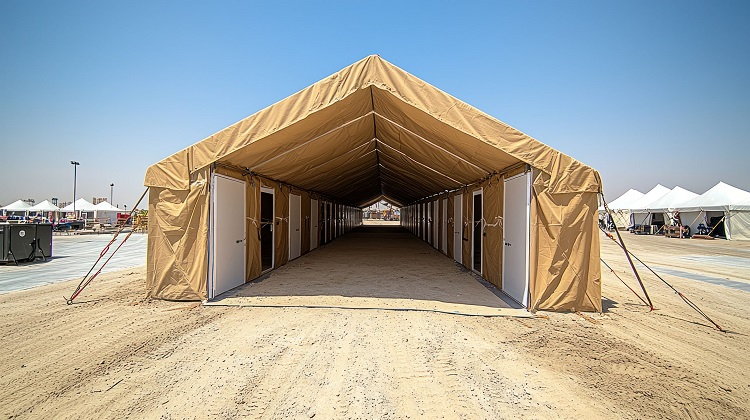The oil and gas industry operates in some of the most remote and challenging environments on Earth, from Arctic tundras to scorching deserts. Traditional construction methods typically fall short in these regions due to logistical complexities, harsh weather conditions, and the need for rapid deployment. Modular fabric structures have emerged as a game-changing solution, offering durability, flexibility, and cost-efficiency. These innovative buildings are transforming remote operations by addressing critical challenges in ways conventional structures can’t.
Read on to learn how modular fabric structures revolutionize remote oil and gas operations.
Table of Contents
The Challenges of Remote Oil & Gas Operations
Remote oil and gas sites face unique obstacles, including extreme temperatures, high winds, and limited access to construction materials. Transporting heavy building components over long distances is costly and time-consuming. Additionally, temporary shelters must withstand harsh conditions while providing safe, functional spaces for workers and equipment. Traditional rigid structures often require extensive site preparation and extended construction timelines, delaying project starts and increasing expenses.
This is where investing in pre-engineered fabric buildings comes into play. Designed for rapid deployment and engineered to endure severe climates, these structures can provide a reliable alternative to conventional construction. Their lightweight yet durable materials can reduce transportation costs while maintaining structural integrity in demanding environments.
Advantages of Modular Fabric Structures
Modular fabric structures offer several advantages. These include:
Rapid Deployment and Mobility
In the oil and gas industry, time directly impacts profitability. Extended setup periods for traditional structures result in costly delays, stalled production, and missed deadlines. Modular fabric structures can eliminate these inefficiencies with swift assembly, ensuring faster operational readiness. Their portability can further enhance efficiency, allowing seamless relocation as projects progress or sites change. This agility can help reduce downtime, optimize resource allocation, and keep projects on schedule, ultimately safeguarding revenue streams.
Durability in Extreme Conditions
Engineered for resilience, fabric buildings can utilize high-strength steel frames and industrial-grade membranes to endure punishing conditions from Arctic blizzards to coastal storms. Their tensioned designs can efficiently shed snow, resist wind uplift, and repel corrosion.
Rigorous testing also ensures compliance with applicable regulatory standards, certifying their reliability in explosive atmospheres or seismic zones. This robust construction can guarantee uninterrupted operations in the planet’s most hostile environments while minimizing maintenance demands over decades of service.
Cost-Effectiveness
Permanent construction in remote oil and gas sites requires expensive material transport, specialized labor, and extensive site work, driving costs exponentially higher. Fabric buildings slash expenses through lightweight modular components that ship efficiently and install rapidly with minimal crews. Translucent membranes can also maximize daylight, reducing lighting costs, while insulated options can optimize thermal efficiency.
Unlike traditional structures, they require no painting, roofing repairs, or structural upkeep, delivering lifetime cost savings compared to conventional buildings.
Customization and Scalability
The dynamic nature of oil and gas operations demands adaptable infrastructure. Fabric structures can provide unmatched versatility with column-free interiors spanning over 150 feet, accommodating massive drilling equipment and mobile workstations. Customizable features include crane systems, HVAC integration, and partition walls for segregated workspaces.
As projects scale, modular extensions can be added without shutdowns. This reconfigurable design for future-proofs operations allows seamless transitions between storage, maintenance, and crew housing needs throughout a site’s lifecycle.
Applications in Oil & Gas Operations
Modular fabric structures can provide flexible, durable solutions for oil and gas operations. Below are some applications to consider:
Equipment Storage and Maintenance
Fabric structures can create optimal protective environments for critical oilfield equipment, shielding million-dollar machinery from UV degradation, moisture corrosion, and temperature extremes. Their tension membrane roofs eliminate water pooling while wind-rated designs prevent structural failure during storms. The unobstructed interiors, free of support columns, can also enable 360° equipment access for streamlined servicing.
Moreover, large roll-up doors can accommodate vehicle movement, while insulated fabrics can maintain stable interior conditions to protect sensitive electronics and prevent fluid freezing in arctic operations.
Workforce Accommodations
Fabric structures can transform remote work camps into habitable communities through climate-controlled modular units. Engineered insulation systems maintain consistent temperatures from -60°F to 120°F, while integrated HVAC and positive-pressure ventilation systems filter dust and regulate humidity. These customizable spaces can include partitioned sleeping pods, commercial kitchens, and entertainment areas with full lighting systems.
Moreover, fire-retardant materials and emergency exit meet strict workforce housing standards, ensuring both comfort and compliance in isolated locations for extended rotations.
Emergency Response and Temporary Facilities
When emergencies strike, fabric buildings serve as instant infrastructure erected within hours to create fully functional crisis response hubs. Their rapid-deploy systems can transform empty sites into operational command centers with power-ready designs for communications equipment, triage stations with sterile environments, or secure containment zones for hazardous materials.
Also, weatherproof structures can maintain functionality during extreme events, while their modular nature allows for immediate relocation as incident perimeters shift, ensuring continuous emergency management capability.
Environmental and Regulatory Compliance
The oil and gas industry faces mounting pressure to adopt sustainable practices, and fabric structures deliver environmentally conscious solutions. These buildings can incorporate recyclable steel frames and PVC membranes with extended lifecycles, minimizing waste. Energy-saving features like solar-ready roofs and passive ventilation systems can reduce fuel consumption in off-grid locations.
Also, engineers can precisely calibrate each structure to meet jurisdictional climate zone requirements and standards, ensuring regulatory compliance while achieving lower embodied carbon than traditional construction methods.
Conclusion
Modular fabric structures are revolutionizing remote oil and gas operations by providing durable, flexible, and cost-effective solutions. Their ability to withstand extreme conditions, rapid deployment, and scalability make them indispensable in challenging environments. As the industry continues to evolve, these innovative buildings can play an even greater role in enhancing efficiency, safety, and sustainability. With the information mentioned above in mind, companies looking to optimize their remote operations should consider the advantages of modern fabric structures as a strategic investment.

